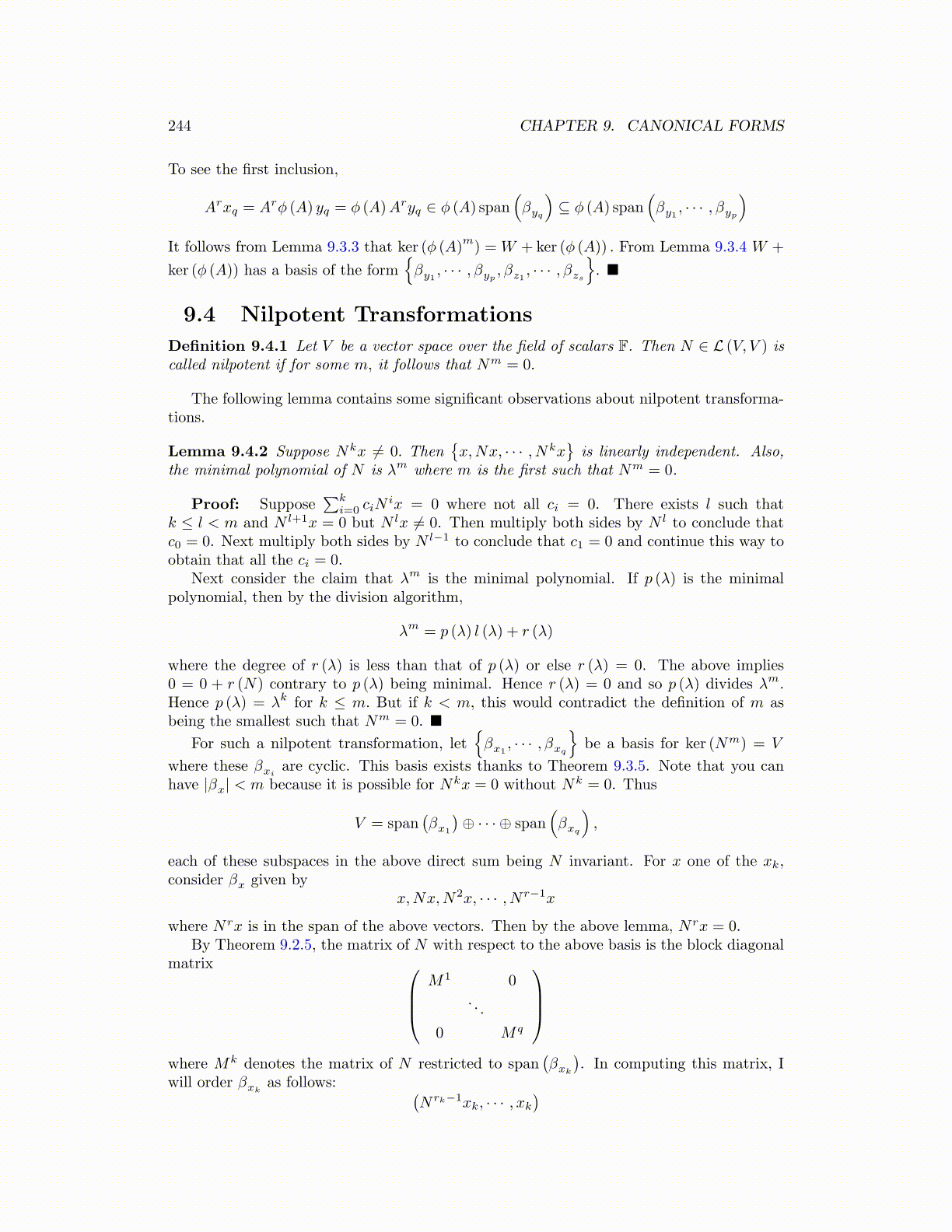
244 CHAPTER 9. CANONICAL FORMS
To see the first inclusion,
Arxq = Arϕ (A) yq = ϕ (A)Aryq ∈ ϕ (A) span(βyq
)⊆ ϕ (A) span
(βy1
, · · · , βyp
)It follows from Lemma 9.3.3 that ker (ϕ (A)
m) =W + ker (ϕ (A)) . From Lemma 9.3.4 W +
ker (ϕ (A)) has a basis of the form{βy1
, · · · , βyp, βz1 , · · · , βzs
}. ■
9.4 Nilpotent Transformations
Definition 9.4.1 Let V be a vector space over the field of scalars F. Then N ∈ L (V, V ) iscalled nilpotent if for some m, it follows that Nm = 0.
The following lemma contains some significant observations about nilpotent transforma-tions.
Lemma 9.4.2 Suppose Nkx ̸= 0. Then{x,Nx, · · · , Nkx
}is linearly independent. Also,
the minimal polynomial of N is λm where m is the first such that Nm = 0.
Proof: Suppose∑k
i=0 ciNix = 0 where not all ci = 0. There exists l such that
k ≤ l < m and N l+1x = 0 but N lx ̸= 0. Then multiply both sides by N l to conclude thatc0 = 0. Next multiply both sides by N l−1 to conclude that c1 = 0 and continue this way toobtain that all the ci = 0.
Next consider the claim that λm is the minimal polynomial. If p (λ) is the minimalpolynomial, then by the division algorithm,
λm = p (λ) l (λ) + r (λ)
where the degree of r (λ) is less than that of p (λ) or else r (λ) = 0. The above implies0 = 0 + r (N) contrary to p (λ) being minimal. Hence r (λ) = 0 and so p (λ) divides λm.Hence p (λ) = λk for k ≤ m. But if k < m, this would contradict the definition of m asbeing the smallest such that Nm = 0. ■
For such a nilpotent transformation, let{βx1
, · · · , βxq
}be a basis for ker (Nm) = V
where these βxiare cyclic. This basis exists thanks to Theorem 9.3.5. Note that you can
have |βx| < m because it is possible for Nkx = 0 without Nk = 0. Thus
V = span(βx1
)⊕ · · · ⊕ span
(βxq
),
each of these subspaces in the above direct sum being N invariant. For x one of the xk,consider βx given by
x,Nx,N2x, · · · , Nr−1x
where Nrx is in the span of the above vectors. Then by the above lemma, Nrx = 0.By Theorem 9.2.5, the matrix of N with respect to the above basis is the block diagonal
matrix M1 0
. . .
0 Mq
where Mk denotes the matrix of N restricted to span
(βxk
). In computing this matrix, I
will order βxkas follows: (
Nrk−1xk, · · · , xk)